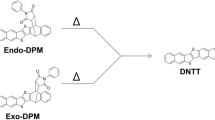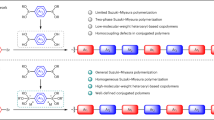Abstract
We synthesized a polythiophene derivative containing a photocleavable coumarin unit in the side chain. The resulting polymer contained 56% coumarin units with a number-average molecular weight of 17,000. When a film of the polythiophene derivative was irradiated at 313 nm, 54% of the coumarin groups were photocleaved. Fourier transform infrared spectroscopy revealed that the photocleaved side chains were transformed to carboxyl groups. Formation of the carboxyl group changed the nature of the surface of the polymer film from hydrophobic to hydrophilic. Furthermore, photocleavage of the coumarin unit changed the solubility of the polymer in organic solvents. Taking advantage of this solubility change, we photopatterned the polythiophene film using a photomask. In addition, the photocleaved polythiophene film showed a 104-fold increase in electrical conductivity after chemical doping.
This is a preview of subscription content, access via your institution
Access options
Subscribe to this journal
Receive 12 print issues and online access
$259.00 per year
only $21.58 per issue
Buy this article
- Purchase on Springer Link
- Instant access to full article PDF
Prices may be subject to local taxes which are calculated during checkout









Similar content being viewed by others
References
Ostroverkhova O. Organic optoelectronic materials: mechanisms and applications. Chem Rev. 2016;116:13279–412.
Kaloni TP, Giesbrecht PK, Schreckenbach G, Freund MS. Polythiophene: from fundamental perspectives to applications. Chem Mater. 2017;29:10248–83.
Aoki H, Saito H, Shimoyama Y, Kuwabara J, Yasuda T, Kanbara T. Synthesis of conjugated polymers containing octafluorobiphenylene unit via Pd-catalyzed cross-dehydrogenative-coupling reaction. ACS Macro Lett. 2018;7:90–94.
Yang J, Xiao B, Tang A, Li J, Wang X, Zhou E. Aromatic-diimide-based n-type conjugated polymers for all-polymer solar cell applications. Adv Mater. 2019;31:1804699.
Lin P-S, Shoji Y, Afraj SN, Ueda M, Lin C-H, Inagaki S, et al. Controlled synthesis of poly[(3-alkylthio)thiophene]s and their application to organic field-effect transistors. ACS Appl Mater Interfaces. 2021;13:31898–909.
Li G, Chang W-H, Yang Y. Low-bandgap conjugated polymers enabling solution-processable tandem solar cells. Nat Rev Mater. 2017;2:17043.
Wang M, Baek P, Akbarinejad A, Barker D, Travas-Sejdic J. Conjugated polymers and composites for stretchable organic electronics. J Mater Chem C. 2019;7:5534–52.
Freudenberg J, Jänsch D, Hinkel F, Bunz UHF. Immobilization strategies for organic semiconducting conjugated polymers. Chem Rev. 2018;118:5598–689.
Yang Y, Liu Z, Zhang G, Zhang X, Zhang D. The effects of side chains on the charge mobilities and functionalities of semiconducting conjugated polymers beyond solubilities. Adv Mater. 2019;31:1903104.
Kim MJ, Lee M, Min H, Kim S, Yang J, Kweon H, et al. Universal three-dimensional crosslinker for all-photopatterned electronics. Nat Commun. 2020;11:1520.
Sun W, Xie L, Guo X, Su W, Zhang Q. Photocross-linkable hole transport materials for inkjet-printed high-efficient quantum dot light-emitting diodes. ACS Appl Mater Interfaces. 2020;12:58369–77.
Saito Y, Sakai Y, Higashihara T, Ueda M. Direct patterning of poly(3-hexylthiophene) and its application to organic field-effect transistor. RSC Adv. 2012;2:1285–8.
He P, Shimano S, Salikolimi K, Isoshima T, Kakefuda Y, Mori T, et al. Noncovalent modification of single-walled carbon nanotubes using thermally cleavable polythiophenes for solution-processed thermoelectric films. ACS Appl Mater Interfaces. 2019;11:4211–8.
Sun B, Hong W, Aziz H, Li Y. Diketopyrrolopyrrole-based semiconducting polymer bearing thermocleavable side chains. J Mater Chem. 2012;22:18950–5.
Liu J, Kadnikova EN, Liu Y, McGehee MD, Fréchet JMJ. Polythiophene containing thermally removable solubilizing groups enhances the interface and the erformance of polymer−titania hybrid solar cells. J Am Chem Soc. 2004;126:9486–7.
Hu X, Lawrence JA, Mullahoo J, Smith ZC, Wilson DJ, Mace CR, et al. Directly photopatternable polythiophene as dual-tone photoresist. Macromolecules. 2017;50:7258–67.
Hu X, Qureishi Z, Thomas SW. Light-controlled selective disruption, multilevel patterning, and sequential release with polyelectrolyte multilayer films incorporating for photocleavable chromophores. Chem Mater. 2017;29:2951–60.
Smith ZC, Pawle RH, Thomas SW. Photoinduced aggregation of polythiophenes. ACS Macro Lett. 2012;1:825–9.
Schmatz B, Yuan Z, Lang AW, Hernandez JL, Reichmanis E, Reynolds JR. Aqueous processing for printed organic electronics: conjugated polymers with multistage cleavable side chains. ACS Cent Sci. 2017;3:961–7.
Schelkle KM, Bender M, Jeltsch K, Buckup T, Müllen K, Hamburger M, et al. Light-induced solubility modulation of polyfluorene to enhance the performance of OLEDs. Angew Chem Int Ed. 2015;54:14545–8.
Luo J, Uprety R, Naro Y, Chou C, Nguyen DP, Chin JW, et al. Genetically encoded optochemical probes for simultaneous fluorescence reporting and light activation of protein function with two-photon excitation. J Am Chem Soc. 2014;136:15551–8.
Ando H, Furuta T, Tsien RY, Okamoto H. Photo-mediated gene activation using caged RNA/DNA in zebrafish embryos. Nat Genet. 2001;28:317–25.
Furuta T, Wang SS-H, Dantzker JL, Dore TM, Bybee WJ, Callaway EM, et al. Brominated 7-hydroxycoumarin-4-ylmethyls: photolabile protecting groups with biologically useful cross-sections for two photon photolysis. Proc Natl Acad Sci USA. 1999;96:1193–200.
Schmidt R, Geissler D, Hagen V, Bendig J. Mechanism of photocleavage of (coumarin-4-yl)methyl esters. J Phys Chem A. 2007;111:5768–74.
Matthews JR, Goldoni F, Schenning APHJ, Meijer EW. Non-ionic polythiophenes: a non-aggregating folded structure in water. Chem Commun, 5503-5 https://pubs.rsc.org/en/content/articlelanding/2005/cc/b512119a (2005).
Salikolimi K, Kawamoto M, He P, Aigaki T, Ito Y. Polythiophene nanoparticles that display reversible multichromism in aqueous media. Polym J. 2017;49:429–37.
Acknowledgements
We thank the Support Unit of Bio-Material Analysis, Research Resources Center, RIKEN Brain Science Institute for performing the HRMS measurements. We also thank Prof. Dr. Keisuke Tajima and Dr. Kyohei Nakano of the Emergent Functional Polymers Research Team, RIKEN Center for Emergent Matter Science, for the electrical conductivity measurements. We thank Edanz Group (https://jp.edanz.com/ac) for editing a draft of this manuscript.
Author information
Authors and Affiliations
Corresponding authors
Ethics declarations
Conflict of interest
The authors declare no competing interests.
Additional information
Publisher’s note Springer Nature remains neutral with regard to jurisdictional claims in published maps and institutional affiliations.
Supplementary information
Rights and permissions
About this article
Cite this article
Muralidhar, J.R., Kodama, K., Hirose, T. et al. Photocleavage behavior of a polythiophene derivative containing a coumarin unit. Polym J 54, 191–198 (2022). https://doi.org/10.1038/s41428-021-00574-z
Received:
Revised:
Accepted:
Published:
Issue Date:
DOI: https://doi.org/10.1038/s41428-021-00574-z



